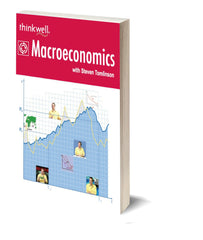
Honors Macroeconomics Online Course
$159.00
Thinkwell's Honors Macroeconomics
Thinkwell's Honors Macroeconomics follows a syllabus typically used in a one-semester college-level course. Taught by acclaimed Professor Steven Tomlinson, one of America's most talented professors, it's a great way to learn the economics of markets and countries, and how they interact.
Pairing Honors Macroeconomics with its sister course, Honors Microeconomics, comprises a one-year curriculum. Our Honors Economics course is simply a combination of both Honors Macroeconomics and Honors Microeconomics.
The Printed Notes (optional) are the Honors Macroeconomics course notes from the Online Subscription printed in color, on-the-go format.





